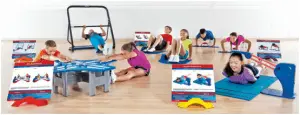
But, are they using it correctly?
According to the Cooper Institute, “FITNESSGRAM® is a comprehensive educational, reporting and promotional tool used to assess physical fitness and physical activity levels for children. It was first developed in 1982 by the Cooper Institute and is the most widely used children’s health-related physical fitness assessment in the world.”
As a teacher, I find a great deal of value using a fitness assessment. Being able to effectively measure upper-body strength (90-degree push-ups), abdominal strength and endurance (pacer curl-ups), aerobic capacity (PACER), and flexibility (Back Saver V-Sit & Reach and Trunklift) provided me with data that we used to design and cater our physical education program to our students. It was also a valuable tool that we used for student goal setting and basic fitness planning.
In the state of Virginia, all schools with students in grades 4-12 are supposed to report FITNESSGRAM® data with the Department of Education. The Department of Education (DOE) makes the yearly results available on the DOE website. Using that information, teachers can compare their school’s scores to other school divisions and the state average and identify strengths and weaknesses in the different fitness areas for their students.
Since all schools need to submit the test results, teachers are trained using the FITNESSGRAM® assessment. An essential component of the training should be a connection between performing the assessment and using the data to drive decisions to focus programming that bolsters areas of weakness that were determined by data analysis. Students can use their own data to begin analyzing personal fitness data and planning, which is clearly a higher-order thinking task that requires students to know and apply what they have learned about health-related fitness through effective instruction. Ultimately, FITNESSGRAM® should be used as a tool to guide students to make healthy decisions regarding physical activity and personal fitness.
Sadly, there are schools were physical educators have not taken advantage of these best-practices and learning opportunities. Some teachers see the fitness assessment as a requirement that they must complete but fail to use the data to adapt their program to meet the needs of the students that they teach. Another troubling practice is grading students based on FITNESSGRAM® results. Based on research, a considerable portion of student performance is based student age and heredity. These facts may cause fitness results that do not reflect the efforts of a child who is working hard to improve scores. Many teachers defend the use of grading for fitness scores because they measure the amount of improvement. Although that is a better option, there are still challenges determining the level of effort that student give when participating in the pre-assessment. It also has the potential to penalize skilled athletes who may perform well in the pre-assessment because they are “in season” only to perform at a lower level on the post-assessment.
To wrap it all up, FITNESSGRAM® is a tool designed to measure student fitness levels. This tool should be used to empower student to take ownership of their personal fitness and learn a variety of ways to increase fitness levels, improve areas of weakness, and increase physical activity levels. Most importantly, teachers need to discontinue the inappropriate practice of grading fitness assessments and focus on student learning and application of important fitness concepts.
Take the stress out of fitness testing with AssessPro®, the most convenient and efficient fitness testing equipment available! (Compatible with FITNESSGRAM®)





